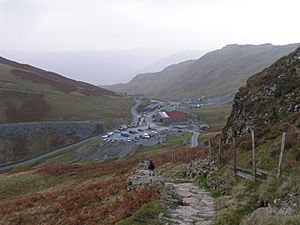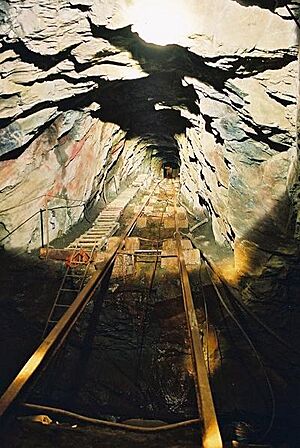Honister Slate Mine facts for kids
The Honister Slate Mine in Cumbria, England, is a special place. It's the very last working slate mine in the country! People have been digging for Westmorland green slate here since 1728. Besides being a working mine, it's also a super popular place for tourists to visit in the beautiful Lake District National Park.
Contents
History of Honister Mine
People started digging for slate at Honister a long time ago, in the late 1600s. At first, they dug in open pits, like big holes in the ground. But as they needed more and more slate, they started digging tunnels deep underground.
The 1800s: Growing Bigger
By 1870, the underground tunnels at Honister stretched far under Honister Crag. There were also other digging spots across the valley at Yew Crags. Smaller mines were found at Dubbs Moor too.
In the past, workers used packhorse teams to carry the heavy slate out of the mines. They would load the slate onto sleds and bring them down very steep paths. This was a tough job!
In 1879, new owners took over the mine. They built amazing "self-acting inclines." These were like special ramps that used gravity to move slate up and down, making the work much faster and easier. Even though they cost a lot to build, they really helped the mine. One of these inclines at Yew Crags was so good that it was used until the late 1960s!
By 1891, the mine was producing 3,000 tons of slate every year. More than 100 people worked there.
The 1900s: Changes and Challenges
During the First World War, there weren't enough workers, so the mines had to slow down. But after the war, they started up again quickly.
In 1926, a new manager named Robin Hoare helped the mine become even more successful. They made many changes, like adding electricity to the main work area. They also started a new mine called Kimberley Mine.
The Dubbs Quarry stopped producing slate in 1932. It was just too hard and slow to get the finished slate out of that area.
The mine had to close again for a few years during the Second World War (from 1943 to 1945). But after that, they kept digging slate through the 1950s and 1960s. The Yew Crag mine closed in 1966 because the roof of the tunnels became unsafe.
Mine Closure and Reopening
In 1981, a father and son, B.R. Moore and R.D. Moore, bought the quarries. They made many improvements, bringing in new machines and better ways to work underground. This was the first time such modern equipment was used in a Lake District quarry.
In 1985, the Moore family sold the company to a bigger company called Alfred McAlpine. This company already owned another famous quarry in Wales. McAlpine opened a new open-pit mine at Honister. However, in 1989, McAlpine stopped all mining operations at Honister.
What to See and Do at Honister Mine
In 1997, a local businessman named Mark Weir reopened the mine. He started producing a small amount of roofing slate again. But he also had a great idea: turn the mine into a fun place for tourists!
Today, a special narrow-gauge railway helps move slate around the mine.
At Honister, you can visit a special center for visitors. You can also take tours deep underground to see how the miners worked.
One of the most exciting attractions is England's first via ferrata. This is a special climbing path on a cliff. You wear a safety harness and clip yourself to steel cables as you climb. It's a challenging and exciting adventure! In 2011, it even won an award for being the "Best Tourism Experience in The Lake District."
The Zip Wire Project
Honister Mine was featured in a TV show in 2011. The show followed the owner, Mark Weir, as he tried to get permission to build a zip wire from the top of Fleetwith Pike down to the mine. Sadly, Mark Weir passed away in March 2011.
After his death, the plan for the zip wire faced challenges. In 2012, the local park authority said no to the zip wire because they were worried about its impact on the beautiful landscape. However, in 2018, permission was finally given for the 1-kilometer (about 0.6 miles) long zip wire to be built.





